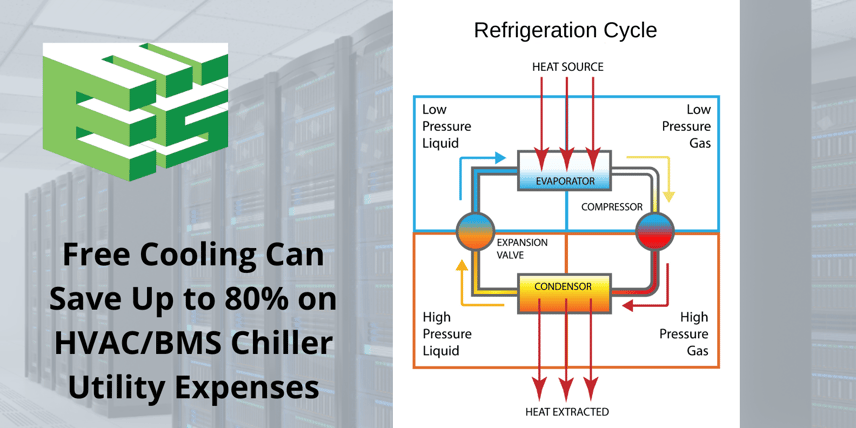

Article by EES Founder and President Pat Miller.
Click here to download more details on free cooling!
Chilled water plants produce cool water for processes and occupants’ comfort via HVAC and the building management system (BMS). Many plants need to produce chilled water all year - 24/7/265. These plants present an opportunity to take advantage of “Mother Nature” to provide that water for only 20% the cost of running a normal plant, saving 80% in utility expenses. How? With free cooling!
Free cooling means exactly what it implies – you shut down the refrigeration system’s condenser, yet still make chilled water at a fraction of the cost. Although the compressor is turned off, free cooling is not completely free since certain fans and other equipment has to run, so perhaps we should rename it “nearly free cooling.”
Economics Behind Free Cooling
Most plants are now producing chilled water for about 0.95 kW/ton (12,000 BTUs). Of that amount, the ancillary pieces take about 0.2 kW/ton and the actual chiller about 0.75 kW/ton.
Free cooling is derived by replacing the chiller with a heat exchanger in parallel with the chiller’s evaporator (the actual chilled water that is produced to cool the building or process). This saves the cost of the mechanical refrigeration or about 0.75 kW/ ton.
When outside conditions are right (usually in the shoulder seasons), free cooling is activated and the chiller is taken offline. With intelligent and sophisticated software, this free cooling option can be employed up to 2,500 hours per year (8,760 hours yearly total), or about 28% of the year where the location and associated weather allows.
What’s Required to Take Advantage of Chilled Water Savings?
An efficient heat exchanger is the key to maximizing savings. Typically, a plate-and-frame heat exchanger with the tonnage capacity to produce chilled water with a 2-degree Fahrenheit approach (cold condenser water in and exchange with chilled water out on the other side).
There are three other important pieces you’ll need:
- Instruments that are of industrial quality for outside air conditions, water temperatures and chiller pressures
- An industrial computer capable of start / stop, digital / analog inputs and outputs with speed and PID (proportional, integral, and derivative) capability
- Software to operate the sequences that need to be followed to allow operation in various outside conditions
What Pitfalls Need to be Addressed?
Like any solution, free cooling isn’t perfect. It’s important for end users to know what to consider when deploying free cooling so that they don’t face unpleasant outcomes. One pitfall of free cooling is that very cold temperatures can cause icing in the cooling tower.
Consider intermittent operation that allows for free cooling for some of the time versus mechanical refrigeration (chiller on) for the rest of the time. This allows for more hours of free cooling.
The free cooling system also needs control of condenser water temperatures for operation of the chiller with cold condenser water, which may cause chiller failure on low condenser pressure. Finally, the plate-and-frame heat exchanger needs to be cleaned once a year.
Is Free Cooling Worth It?
The savings can be calculated versus the cost of the change, but in most buildings that require year-round cooling, it certainly has proven to be very successful and profitable. With utility costs rising, there has never been a better time to implement free cooling into your HVAC/BMS chilled water system.
EES has many clients that are using this capability and are reaping the benefits, not only in dollars saved, but also hours of operation saved by not using the chiller. Interested in learning how free cooling could help your facility? Reach out to EES here.
Interested in Learning More?
Download this PDF and get a deeper dive into Free Cooling!


